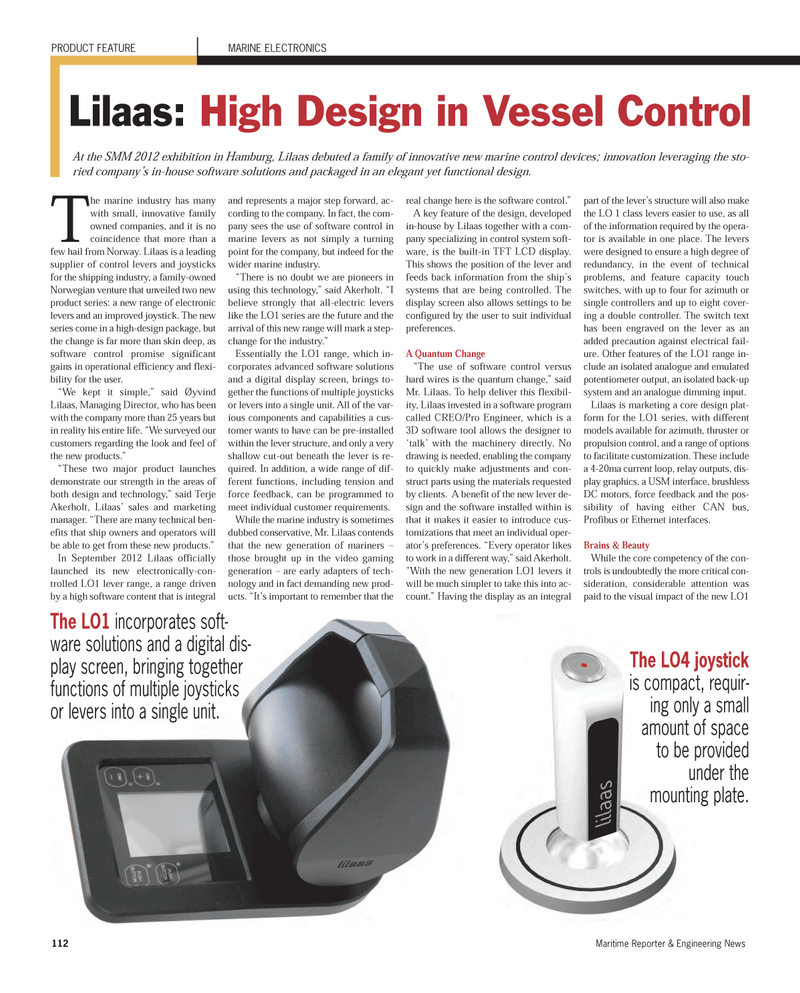
Page 112: of Maritime Reporter Magazine (November 2012)
Workboat Annual
Read this page in Pdf, Flash or Html5 edition of November 2012 Maritime Reporter Magazine
112Maritime Reporter & Engineering News The marine industry has many with small, innovative family owned companies, and it is no coincidence that more than afew hail from Norway. Lilaas is a leading supplier of control levers and joysticks for the shipping industry, a family-owned Norwegian venture that unveiled two new product series: a new range of electronic levers and an improved joystick. The new series come in a high-design package, but the change is far more than skin deep, as software control promise significant gains in operational efficiency and flexi- bility for the user. ?We kept it simple,? said Øyvind Lilaas, Managing Director, who has been with the company more than 25 years but in reality his entire life. ?We surveyed our customers regarding the look and feel of the new products.? ?These two major product launches demonstrate our strength in the areas ofboth design and technology,? said Terje Akerholt, Lilaas? sales and marketing manager. ?There are many technical ben- efits that ship owners and operators will be able to get from these new products.? In September 2012 Lilaas officially launched its new electronically-con- trolled LO1 lever range, a range driven by a high software content that is integral and represents a major step forward, ac- cording to the company. In fact, the com- pany sees the use of software control in marine levers as not simply a turning point for the company, but indeed for the wider marine industry. ?There is no doubt we are pioneers inusing this technology,? said Akerholt. ?I believe strongly that all-electric levers like the LO1 series are the future and the arrival of this new range will mark a step- change for the industry.? Essentially the LO1 range, which in-corporates advanced software solutions and a digital display screen, brings to-gether the functions of multiple joysticks or levers into a single unit. All of the var- ious components and capabilities a cus-tomer wants to have can be pre-installed within the lever structure, and only a very shallow cut-out beneath the lever is re- quired. In addition, a wide range of dif-ferent functions, including tension andforce feedback, can be programmed tomeet individual customer requirements. While the marine industry is sometimesdubbed conservative, Mr. Lilaas contends that the new generation of mariners ? those brought up in the video gaming generation ? are early adapters of tech-nology and in fact demanding new prod- ucts. ?It?s important to remember that the real change here is the software control.? A key feature of the design, developed in-house by Lilaas together with a com-pany specializing in control system soft- ware, is the built-in TFT LCD display. This shows the position of the lever and feeds back information from the ship?s systems that are being controlled. The display screen also allows settings to be configured by the user to suit individual preferences.A Quantum Change?The use of software control versus hard wires is the quantum change,? said Mr. Lilaas. To help deliver this flexibil- ity, Lilaas invested in a software program called CREO/Pro Engineer, which is a 3D software tool allows the designer to ?talk? with the machinery directly. No drawing is needed, enabling the company to quickly make adjustments and con- struct parts using the materials requestedby clients. A benefit of the new lever de- sign and the software installed within is that it makes it easier to introduce cus- tomizations that meet an individual oper- ator?s preferences. ?Every operator likes to work in a different way,? said Akerholt. "With the new generation LO1 levers it will be much simpler to take this into ac- count.? Having the display as an integral part of the lever?s structure will also make the LO 1 class levers easier to use, as all of the information required by the opera- tor is available in one place. The levers were designed to ensure a high degree of redundancy, in the event of technical problems, and feature capacity touchswitches, with up to four for azimuth orsingle controllers and up to eight cover- ing a double controller. The switch text has been engraved on the lever as an added precaution against electrical fail- ure. Other features of the LO1 range in-clude an isolated analogue and emulatedpotentiometer output, an isolated back-upsystem and an analogue dimming input.Lilaas is marketing a core design plat- form for the LO1 series, with different models available for azimuth, thruster or propulsion control, and a range of optionsto facilitate customization. These include a 4-20ma current loop, relay outputs, dis-play graphics, a USM interface, brushless DC motors, force feedback and the pos-sibility of having either CAN bus, Profibus or Ethernet interfaces. Brains & BeautyWhile the core competency of the con- trols is undoubtedly the more critical con-sideration, considerable attention was paid to the visual impact of the new LO1 PRODUCT FEATURE MARINE ELECTRONICSLilaas: High Design in Vessel Control At the SMM 2012 exhibition in Hamburg, Lilaas debuted a family of innovative new marine control devices; innovation leveraging the sto-ried company?s in-house software solutions and packaged in an elegant yet functional design. The LO1incorporates soft-ware solutions and a digital dis-play screen, bringing together functions of multiple joysticksor levers into a single unit.The LO4 joystick is compact, requir- ing only a smallamount of spaceto be providedunder the mounting plate.MR#11 (106-113):MR Template 11/6/2012 10:54 AM Page 112

 111
111

 113
113
